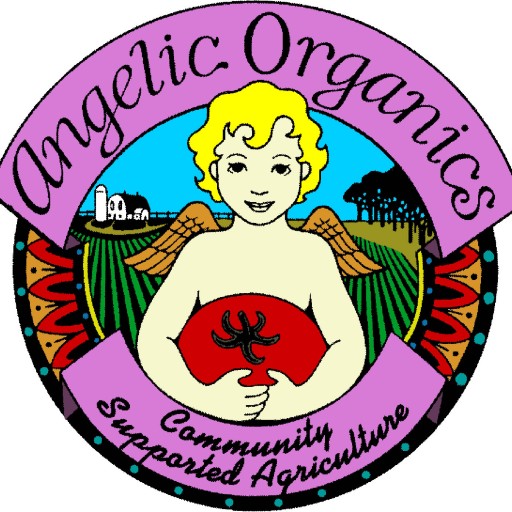4th Harvest Week: Wednesday/Thursday Delivery, July 6th & 7th, 2011
Greetings, Shareholders!
Vegetable of the Week is Cabbage. One head may occupy a large corner of your family-sized refrigerator, prompting you to ask, “What are we going to do with this brute?” A great solution is to learn a few ways to cook it, and make dishes that are loaded with it to share with friends and family at picnics and potlucks. With its sweet, refreshing flavor and crisp texture, cabbage is worthy of much higher status than it is usually accorded. Leaves around leaves around leaves, cabbage turns sweet when steamed or gently boiled. Or, slice it super-thin and use it instead of bean sprouts in stir-fries.
Box Contents
Brassicas – Cabbage &/or Kohlrabi; a few boxes will have the last of the spring broccoli
Fruiting Crops – Zucchini and/or Summer Squash
Salad Greens – Head Lettuce
Cooking Greens – Swiss Chard
Roots – Shunkyo Radishes & Beets; maybe a colorful Chioggia Beet
Alliums – Scallions
Herbs – Lemon Balm, Thyme & Oregano
…and now, a recipe from Farmer John’s Cookbook!
Coleslaw with Cilantro and Chives (serves 8 to 10)
4–6 cups shredded cabbage (green, red, or a combination) (2–3 small heads)
1/4 cup minced cilantro
1/4 cup chopped chives
3 tablespoons extra virgin olive oil
3 tablespoons white wine vinegar
2 tablespoons sugar
1 teaspoon salt
– Toss the cabbage, cilantro, and chives in a large bowl or container; refrigerate, covered, for at least 1 hour or overnight. When ready to serve, mix the oil, vinegar, sugar, and salt in a small bowl until well combined. Pour the dressing over the chilled cabbage mixture. Mix well just before serving.
____________________________________
Farmer John Writes…
Yikes!
We usually put 10 to 14 different herbs and vegetables in your box. Besides their multi-faceted journey from seed to field to fruition, they go on quite a journey from the time they are harvested until they are packed into your box. There are over 70 things that have to be decided with each crop from harvest to pack, such as whether to harvest the crop (and what is its location), how many of what kind of containers to take to the field for that crop, what harvest tool to use, when in the day to harvest it, whether to ice it in the field, whether to cover the harvest with a damp cloth while in the field, whether to record it by the head or piece or weight or volume or a combination of these, which cooler to place it in, whether and when to bag it or bunch it, who will put it in your box on our pack line, etc. Since we harvest and pack twice per week, that’s over 700 decisions twice per week. Taggart Siegel, director of The Real Dirt on Farmer John, used to often say, when he was here filming, “running this farm is like directing a film, hundreds of decisions to make each day.”
Relax
Ben Wilson, our farm’s Biodynamic practitioner, and I, with some help from our office whiz Jenny Meyer, came up with 3 directives for proactively and routinely managing these many decisions: Harvest, Post-harvest, and Pack. There are pdf’s of the three directives here, https://angelicorganics.com/HarvestScriptDirectives.pdf, so you have an idea of our weeks during the harvest season at Angelic Organics. Of course, there are many things not addressed in these spreadsheets, such as building fence to keep out deer and raccoons; weeding, seeding and transplanting (which continue here into August); tillage; irrigating; greenhouse work; cover cropping, etc. And I’ll also note that many of the things that the spreadsheet address are standard or routine here, so we don’t have to wonder deeply or probe our souls for each of the 1400+ weekly, considerations, just some of them. Also, note that the directives don’t provide tutorials on exactly how to harvest the vegetables. This ongoing training process is undertaken orally and through demonstration by our growing manager Jonathan Fagan (3rd year on a CSA farm), crew leaders Kim Benzel and Katie Zelten (5th year at Angelic Organics for each), and Maestro Raul Casique (over 10 years at Angelic Organics.)
Properly managing the many factors that influence the box you receive is of utmost importance to us. In the flurry of the ongoing activities here, from 6 in the morning until 5 in the afternoon, with sometimes 20 workers in the fields during all sorts of weather, things can get overlooked or mis-communicated. Having a clearly delineated system and clearly assigned responsibilities for each task will minimize confusion and maximize the quality of your box. I often say “it’s about the box. It’s about what our shareholders experience when they open the box. That’s the thing to always keep in mind as you’re doing the work.”
Our Farm, the Stage
Today, when introducing these directives to the crew, I said, “you might think these are too controlling, too regimenting, but think of it like a play, where you know the lines and the blocking, and then you can work with the nuance, the art of the performance, or in this case, the art of the box, because the rest of it is now taken care of with the script.”
Open House Soon
Come to our open house on July 16: https://angelicorganics.com/summeropenhouse. Experience the sky overhead, the landscape that surrounds you, and the ground under your feet, which all pour their influences into the food you receive from our farm.
Bounty Call!
Our fields are loaded with crops. Please tell your friends about our upcoming 12-Week shares.
Things to do at the Farm
The Learning Center offers many great programs for connecting people to the land and to their food. Take a look at their offerings here. Lots of programs offered in Chicago, too: http://www.learngrowconnect.org/what/urban/chicago/public




I’m loving my boxes so far, even with a family of 5 it can be a challenge to figure out how to make use of all these beautiful vegetables. Last week I made a salad from a recipe on the Whole Foods website which used my cabbage and green onions; it’s the ubiquitous Cabbage/Ramen Noodle salad that a lot of people make, but slightly healthier (uses honey instead of sugar) and my kids all loved it. I substituted sunflower seeds for the sesame seeds and used less oil than they called for, recipe can be found here: http://www.wholefoodsmarket.com/recipes/658